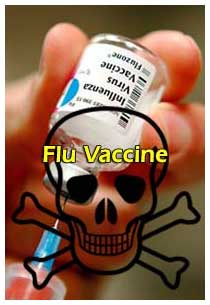Foster and Kimberly Gamble, filmmakers of THRIVE, explain how the Thrive Solutions Model helped stop the toxic aerial spray program in California.
How the Sector Model Helped to Stop Toxic Spray Program in California
Mother concerned about FLU Epidemic caused by Chemtrails – Hollywood Does Chemtrails
Mother concerned about FLU epidemic caused by chemtrails – Hollywood Does Chemtrails U.S. Air Force Study Proposed 2009 Influenza Pandemic in 1996: Kurt Nimmo Infowars March 5, 2009 On June 17, 1996, the U.S. Air Force released Air Force 2025, “a study designed to comply with a directive from the chief of staff of the [...]
Tough Flu Season in U.S., Especially for the Elderly
By DONALD G. McNEIL Jr. - The New York Times - January 18, 2013
 This year’s flu season is shaping up to be “worse than average and particularly bad for the elderly,” Dr. Thomas R. Frieden, the nation’s top federal disease-control official, said Friday.
This year’s flu season is shaping up to be “worse than average and particularly bad for the elderly,” Dr. Thomas R. Frieden, the nation’s top federal disease-control official, said Friday.
But the season appears to have peaked, added Dr. Frieden, the director of the Centers for Disease Control and Prevention, with new cases declining over most of the nation except for the far West.
Spot shortages of flu vaccine and flu-fighting medicine are occurring, but that reflects uneven distribution, not a supply crisis, federal officials said. They urged people seeking flu shots to consult flu.gov and doctors to check preventinfluenza.org for suppliers.
Vaccine makers will ultimately be able to deliver 145 million doses, 10 million more than projected earlier, the officials said. The Food and Drug Administration has allowed the maker of Tamiflu to release two million doses it had in storage.
The older Tamiflu is perfectly good, said Dr. Margaret A. Hamburg, the commissioner of the F.D.A., who joined Dr. Frieden in a telephone news conference. “It’s not outdated, it just has older labeling,” Dr. Hamburg said. “Repackaging it would take weeks,” she added, so her agency told the company not to bother.
Weekly recorded deaths from flu and pneumonia are still rising, and are well above the “epidemic” curve for the first time. But how severe a season ultimately proves depends on how long high weekly death rates persist. Flu deaths often are not recorded until March or April, well after new infections taper off.
Dr. Frieden said the season appeared to resemble the “moderately severe” season of 2003-4, which also had an early start and was dominated by an H3N2 strain. In such seasons, 90 percent of all deaths occur among those over 65. Flu hospitalization rates are “quite high” now, Dr. Frieden said, and most of those hospitalized are elderly.
Last year’s flu season was unusually mild. At the end of the season last year, 34 children had died.
So far this season, the C.D.C.’s count of pediatric flu deaths, which includes premature infants and teenagers up to age 17 — has risen to 29, although this is acknowledged to be an undercount as it is only of lab-confirmed influenza cases reported to the agency.
Henry L. Niman, a flu-watcher who follows state death registries and news reports, counts about 40 pediatric deaths so far and predicted that the total would ultimately be close to the 153 of the 2003-4 season, but much less than in the 2009-10 “swine flu” pandemic, when 282 children died. That flu was a strain never seen before and many more children caught it. The elderly had surprising resistance to getting it, presumably because similar flus that circulated 40 or more years ago had given them some immunity. But among those elderly people who did catch it, the death rates were high.
Dr. Frieden suggested that the elderly avoid contact with sick children.
“Having a grandparent baby-sit a sick child may not be a good idea,” he said.


